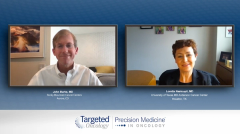
Transplant Eligible Patients With DLBCL
Loretta Nastoupil, MD, and John Burke, MD, discuss transplant as a treatment option for patients with relapsed/refractory [R/R] diffuse large B-cell lymphoma [DLBCL], as well as treatment options for patients with relapsed disease after transplant.
Episodes in this series

John Burke, MD: With [use of] R-CHOP [rituximab, cyclophosphamide, hydroxydaunorubicin, vincristine [Oncovin], prednisone], you generally advise [patients with diffuse large B-cell lymphoma (DLBCL)] that [disease is cured in] about 60% [of patients], and [relapse occurs in] about 40%. Among that 40% [of patients], how do you consider transplant, and what factors do you use to decide who is eligible or not eligible?
Loretta Nastoupil, MD: Again, prior to challenging them with chemotherapy and determining their disease response, I look at age, although not in isolation. I look at age, fitness, and functional status associated with their age. When I have [patients] over the age of 75 [years], I'm probably more considerate of all of these additional factors, including their social support system. It's hard for patients, particularly [those] over the age of 75 years, to relocate to a transplant center or undergo salvage chemotherapy. You could probably even push that number lower. Again, I hesitate to use age in isolation. We look at comorbidities. What's the renal function, cardiac function, lung function, and hepatic function? These all factor in, as well.
The easiest eyeball test that most oncologists will use is, how functional is this patient? And, sometimes, age does impact that. Clearly, we try to enroll our trials, and that's generally our preferred option. But I also recognize that they're only going to select those patients who have no significant comorbidities and good performance status. That's probably why those are the things that impact my decision of whether or not this a candidate for intensive therapy and stem-cell transplant.
John Burke, MD: What about CAR [chimeric antigen receptor] T-cell therapy? In choosing CAR T-cell therapy, do you have different criteria, or are they similar to the transplant criteria?
Loretta Nastoupil, MD: Yes, it's a little bit different. In that setting, we don't consider chemosensitive disease at all. But patients have to be able to tolerate [therapy], particularly if they have high grade CRS [cytokine release syndrome] or ICANS [immune effector cell-associated neurotoxicity syndrome]. That's going to be construct-specific, but because we've been using quite a bit of Axi-cel [axicabtagene ciloleucel] to date, we do recognize that there are higher rates of CRS and ICANS with Axi-cel versus with the other constructs. Again, we do pay attention to functional status. Particularly, we look at the tempo of the disease and if it's growing too rapidly to allow time to receive insurance approval, collect those cells, and undergo manufacturing. That's going to make them a poor CAR T-cell therapy candidate. We also consider social support, because many of these patients will have to be within a radius of a treating center for at least 4 weeks. They can't drive for 8 weeks. It is a larger consideration in a sense, although the disease status outside the tempo of progression doesn't factor in.
Transcript edited for clarity.






































